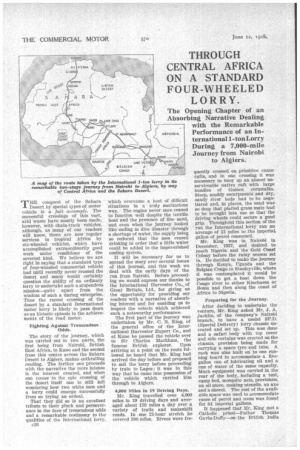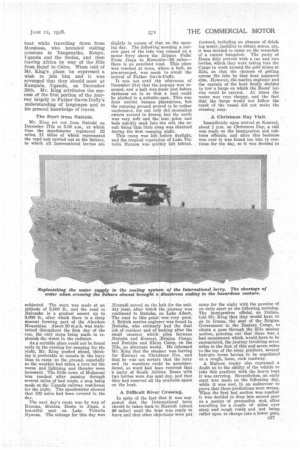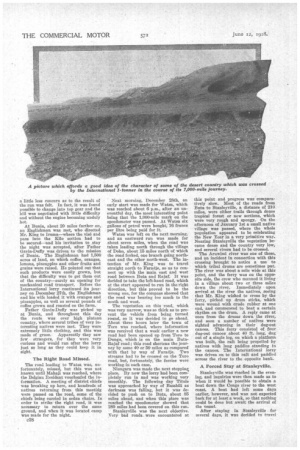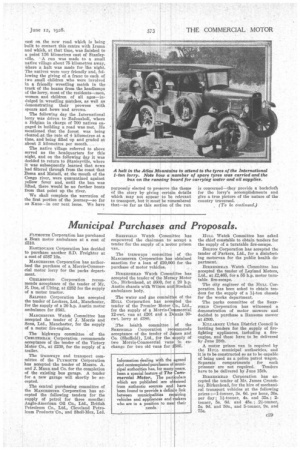THROUGH CENTRAL AFRICA ON A STANDARD FOUR-WHEELED LORRY.
Page 48

Page 49

Page 50

Page 51

If you've noticed an error in this article please click here to report it so we can fix it.
THEHE conquest of the Sahara Desert by special types of motor vehicle is a fait accomph. The successful crossings of this vast, arid waste have mostly been made, however, with chain-track vehicles, although, as many of our readers will kuow, there are now regular services in tropical Africa by six-wheeled vehicles, which have accomplished extraordinarily good work under conditions of the severest kind. We believe we are right in saying that a standard type of four-wheeled conunerciai vehicle had until recently never crossed the desert and many, would certainly question the ability of an ordinary lorry to undertake such a stupendous mission—quite apart from the wisdom of such a daring enterprise. Thus the recent crossing of the desert by a standard International motor lorry is likely to pass down as an historic episode in the achievements of the road motor.
Fighting Against Tremendous Odds.
The story of the journey, which was carried out in two parts, the first being from Nairobi, British East Africa, to Kano and the second from this centre across the Sahara Desert to Algiers, makes enthralling reading. The farther one proceeds with the narrative the more intense is the interest created, and when one comes to the epic crossing of the desert itself one is still left wondering how two white men and a lorry could emerge successfully from so trying an ordeal.
That they did so is an excellent tribute to their pluck and perseverance in the face of tremendous odds and a remarkable testimony to the qualities of the International lorry, c26 which overcame a host of difficult situations in a truly meritorious way. The engine never once ceased to function well despite the terrific heat and the presence of fine sand, and even when the journey looked like ending in dire disaster through a shortage of water, the supply being so reduced that the men ceased drinking in order that a little water could be added to the impoverished cooling system.
It will be necessary for us to spread the story over several issues of this journal, and this week we deal with the early days of the run from Nairobi. Before proceeding we would express our thanks to the International Harvester Co.,. of Great Britain, Ltd., for giving us the opportunity for providing our readers with a narrative of absorbing interest and for enabling us to inspect the vehicle which achieved such a noteworthy performance.
-The first part of the journey was undertaken by Mr. C. N. King, of the general office of the International Harvester Export Co., and at Kano he passed the vehicle over to Sir Charles Markham, the famous British explorer. Upon arriving at a point on the route followed he heard that Mr. King had arrived the day before and proposed to sell the lorry before proceeding by train to Lagos ; it was in this way that he came into possession of the vehicle which carried him through to Algiers.
4,000 Miles in 19 Driving Days.
Mr. King travelled over 4,000 miles in 19 driving days and averaged about 170 miles a day over a variety of trails and makeshift roads. In one 21-hour stretch he covered 380 miles. Rivers were fre quently crossed on primitive canoe rafts, and in one crossing it was necessary to buoy up an almost unserviceable native raft with large bundles of Guinea cornstalks. Steep, muddy escarpments and dry, sandy river beds had to be negotiated and, in places, the sand was so deep that plaited grass mats had to be brought into use so that the driving wheels could secure a good grip. Throughout this section of the run the International lorry ran an average of 21 miles to the imperial. gallon of petrol consumed.
Mr. King was in Nairobi in December, 1927, and desired to reach Nigeria and the Gold Coast Colony before the rainy season set in. He decided to make the journey through Kenya, -Uganda and the Belgian Congo to Stanleyville, where it was contemplated it would be possible to get a boat down the Congo river to either Kinchassa or Boma and then along the coast of Africa to Nigeria.
Preparing for the Journey.
After deciding to undertake the venture, Mr. King asked Mr. 3. A. Jacklin, of the company's Nairobi branch, to have a model SP.D. (Special Delivery) lorry chassis uscrated and set up. This was done and a safari body with top cover and side curtains was erected on the chassis, provision being made for carrying a spare tyre and tube. A rack was also built on" to one running board to accommodate a fivegallon can of lubricating oil and a can of water of the same capacity. Much equipment was carried in the rear of the body, including a tent, camp bed, mosquito nets, provisions, an oil stove, cooking utensils, an axe and a shovel. The rest of the available space was used to accommodate cases of petrol and room was found for 64 imperial gallons.
It happened that Mr. King met a Catholic priest—Father Thomas Gavin-Duffy—on-the British India
boat while travelling down from Mombasa, who intended visiting missions in Tanganyika, Kenya, Uganda and the Sudan, and then leaving Africa by way of the Nile from Rejaf to Cairo. When told of Mr. King's plans he expressed a wish to join him and it was arranged that they -should meet at Kampala, Uganda, on December 20th. Mr. King attributes the success of the first portion of the journey largely to Father Gavin-Duffy's understanding of languages and to his general knowledge of travel.
The Start from Nairobi.
Mr. King set out from Nairobi on December 17th at 5.30 a.m., at which time the speedometer registered 22 miles, 11 miles of which represented the road test carried out at the factory, to which all International lorries are subjected. The start was made at an altitude of 5,500 ft., and the road to Naivasha is a gradual ascent up to 8,000 ft., after which there is a steep descent forming part of the Aberdere Mountains. About 20 m.p.h. was maintained throughout the first day of the run, the only stops being made to replenish the water in the radiator.
As a suitable place could not be found early in the evening for camping for the night, Mr. King pushed ahead, thinking it preferable to remain in the lorry than to camp on the ground, especially as the weather had taken a turn for the worse and lightning and thunder were incessant. The little town of Muhoroni was reached after passing through several miles of bad roads, a atop being made at the Uganda railway rest-house for the night. The speedometer showed that 192 miles had been covered in the day.
The next day's route was by way of Kisumu, 3,funias, Busia to Jinga, beautiful spot on Lake Victoria Nyanza. The mileage for this day was
slightly in excess of that on the opening day. The following morning a narrow part of the lake was crossed On a motor ferry above the Ripport Falls: From Jinga to Kampala-56 miles— there is an excellent road. This place was reached at noon, where a halt, as pre-arranged, was made to await the arrival of Father Gavin-Duffy.
It was not until the afternoon of December 21st that the journey was resumed, and a halt was made just before darkness set in so that a tent could be pitched in a suitablel spot. This was done amidst banana plantations, but the camping ground proved to be rather unpleasant, for not only did mosquitos swarm around in droves, but the earth was very soft and the tent poles and beds quickly sank into the soil, the result being'that little sleep was obtained during the first camping night.
This camp was left before daylight, and the tropical vegetation of Lake Victoria Nyanza was quickly left behind.
Masandi served as the lialt for the midday meal, after which the journey was continued to Butiaba, on Lake Albert. The road to this point was very good. A British marine engineer was found in Butiaba, who evidently had the dual job of resident and of looking after the small steamer which plies between Butiaba and Kesenyi, Belgian Congo, and Butiaba and Rhino Camp, on the Nile' on alternate weeks. He informed Mr. King that the steamer was leaving for Kesenyi on Christmas Eve, and that he was not certain that the lorry and its members could be accommodated, as word had been received that a party of South African Boers with two lorries were due next day, and that they had reserved all the available space on the boat.
A Difficult River Crossing.
In spite of the fact that it was suggested that the International lorry should he taken back to Masindi (about 40 miles) until the boat was ready to leave and that other objections were put
forward, including an absence of drink jug water, inability to obtain stores, etc., it was decided to camp on the verandah of a vacant bungalow. The party of Boers duly arrived with a car and two lorries, which they were taking into the Congo to work around the gold mines at Kilo, so that the chances of getting across the lake by that boat appeared slim. However, the marine engineer and the captain of the boat finally decided to tow a barge on which the Boers' lorries could be carried. At times the water was very choppy, and the fact that the barge would not follow the track of the vessel did not make the crossing easy.
A Christmas Day Visit.
Immediately upon arrival at Kesenyi, about 1 p.m. on Christmas Day, a call was made on the immigration and catoms officials, and after this business was over it was found too late to continue for the day, so it was decided to camp for the night with the promise of an early start on the following morning. The immigration official, an Italian, told Mr. King that they would have to go to Iruma, the seat of the Belgian Government in the Eastern Congo, to obtain a pass through the Kilo mining section, pointing out that there was a bad escarpment which would have to be encountered, the journey involving seven miles to the foot of this and seven miles to the top of the steep gradient, several hair-pin turns having to be negotiated on a rough, loose, rock roadway.
A Maltese trader also expressed a doubt as to the ability of the vehicle to take this gradient with the heavy load it was carrying. Nevertheless, an early start was made on the following day, while it was cool, in an endeavour to prove that these predictions were wrong. When the first bad section was reached it was decided to drop into second gear as a matter of precaution and, after travelling for a couple of miles over steep and rough roads and not being called upon to change into a lower gear,
a little leas concern as to the result of the run was felt. In fact, it -was found possible to change into top gear and the hill was negotiated with little difficulty and without the engine becoming unduly hot.
At Bunia, about 20 miles farther on, an Englishman was met, who directed Mr. King to Truma—where the vise and pass into the Kilo section had to be secured—and his invitation to stay the night was accepted, after Father Gavin-Duffy was driven to the mission of Bunia. The Englishman had 1,500 acres of land, on which coffee, oranges, lemons, pineapples and other fruits and grains were raised. He pointed out that such products were easily grown, but that the difficulty was to get them out of the country—surely an opening for mechanical road transport. Before the International lorry continued its journey on December 27th, the Englishman and his wife loaded it with oranges and pineapples, as well as several pounds of coffee grown and roasted on the farm.
Father Gavin-Duffy was picked up at Bunia, and throughout this day the route was over high plateau country, where several tribes of very interesting natives were met. They wore extremely little clothing, and this was made of grass. Apparently they saw few strangers, for they were very curious and would run after the lorry Just so long as they could keep it iu sight.
The Right Road Missed.
The road leading to Watsa was, unfortunately, missed, but this was not known until Mahaji was reached, where the Belgian Resident vouchsafed the information. A meeting of district chiefs was breaking up here, and hundreds of natives returning from this meetitig -were passed on the road, some of the chiefs being carried in sedan chairs. In order to strike the right road, it was necessary to return over the same ground, and when it was located camp was made for the night.
028
Next morning, December IS-th, an early start was made for Watsa, which was reached about 6 p.m., after an uneventful day, the most interesting point being that the 1,000-mile mark on the speedometer was passed. At Watsa six gallons of petrol were bought, 16 francs per litre being paid for it.
Watsa was left on the next morning, and an eastward run was made for about seven miles, -when the road was taken leading north through the village of Doko, about 15 miles north of which the road forked, one branch going northeast and the other north-west. The intention of Mr. King was to travel straight north to Faradje, so as to connect up with the main east and west road between Buta and Rajaf. It was decided to take the left-hand road, which at the start appeared to run in the right direction, but this proved to be the wrong one, for the compass showed that the road was bearing too much to the south and west.
The vegetation on this road, which was very narrow, was so thick as to prevent the vehicle from being turned round, so it was decided to go ahead. About three hours later the town of Toro was reached, where information was received that a week earlier a new road had been opened up from Toro to Dnngu, which is on the main ButaRajaf road ; this road shortens the journey by some 40 or 50 miles as compared with that by way of Faradje. Two streams had to be crossed on the Toro road, but, fortunatelY, the ferries were working in each ease.
Niangara was made the next stopping, place. By now the lorry had been completely run in and was working very smoothly. The following day Titule was approached by way of )3ambili as darkness was falling, but it was decided to push on to Buta, about 85 miles ahead, and when this place was reached the speedometer showed that 289 miles had been covered on this run.
Stanleyville was the next objective. Very bad roads, were encountered at this point and progress was comparatively slow. Most of the roads from Buta to Stanleyville, a distance of 210 miles, were either trails through dense tropical forest or new sections, which were very rough and spongy. On the afternoon of January 1st a small native village was passed, where the whole population appeared to be celebrating the New Year in a very primitive way. Nearing Stanleyville the vegetation became dense and the country very low, and several rivers had to be crossed.
The Aruwimi river was one of these, and an incident in connection with this crossing brought to notice a use to which tribal drums are sometimes put. The river was about a mile wide at this point, and the ferry was on the oppcssite side, the crew who manned it living in a village about two or three miles down the river. Immediately upon arrival at the river the natives, seeing that Mr. King wished to cross by the ferry, picked up drum sticks, which were wound with crude rubber at one end, and commenced to beat a certain rhythm on the drum. A reply came at once from the drums down the river, and soon a number of natives were sighted advancing in their dug-out canoes. This ferry consisted of four dug-out canoes about 40 ft. long, dug out of a single log, on which a platform was built, the raft being propelled by natives with long paddles standing in the canoes. The International lorry was driven on to this raft and paddled across the river to the opposite bank.
A Forced Stay at Stanleyville.
Stanleyville was reached in the evening, and inquiries were then made as to when it would be possible to obtain a boat down the Congo river to the west coast. A boat had left some days earlier, however, and was not expected back for at least a week, so that nothing could be done but await the arrival of the vessel.
After staying in Stanleyville for several days, it was decided to travel
east on the new road which is being built to conneet this centre with Lama and which, at that time, was finished to a point 186 kilometres east of Stanley
A run was made to a small native village about 75 kilometres away, Where a halt was made for Ihe night. The natives were very friendly arid, following the giving of a franc to each of two small children who were involved in a friendly wrestling match in the track of the beams from the headlamps of the lorry, most of the residents--emen, women and children of all ages—indulged in wrestling matches, as well as demonstrating their prowess with spears and bows and arrows.
The following day the International lorry was driven to Bafouaboli, where a Belgian in charge of 700 natives engaged in building a road was met. He mentioned that the forest was being cleared at the rate of 4 kilometres at a time, and being filled up and graded at about 3 kilometres per month. ..
The native village referred to above served as the headquarters for this night, and on the following day it was decided to return to Stanleyville, where it was subsequently learned that news had filtered through from the coast that Boma and Matadi, at the mouth of the Congo river, were quarantined against yellow fever and, until the ban was lifted, there would be no further boats from that point up the river.
We shall complete the narration of the first portion of the journey—so far as Kano—in our next issue. We have purposely elected to preserve the theme of the story by giving certain details which may not appear to be relevant to transport, but it must he remembered that—so far as this section of the run
is concerned—they provide a backcloth for the lorry's accomplishments and give a true picture of the nature of the country traversed.












































































































